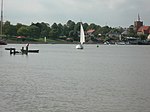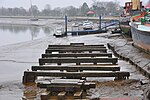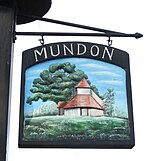Battle of Maldon

The Battle of Maldon took place on 11 August 991 AD near Maldon beside the River Blackwater in Essex, England, during the reign of Æthelred the Unready. Earl Byrhtnoth and his thegns led the English against a Viking invasion. The battle ended in an Anglo-Saxon defeat. After the battle Archbishop Sigeric of Canterbury and the aldermen of the south-western provinces advised King Æthelred to buy off the Vikings rather than continue the armed struggle. The result was a payment of Danegeld of 10,000 Roman pounds (3,300 kg) of silver (approx £1.8M at 2022 prices). An account of the battle, embellished with many speeches attributed to the warriors and with other details, is related in an Old English poem which is usually named The Battle of Maldon. A modern embroidery created for the millennium celebration in 1991 and, in part, depicting the battle, can be seen at the Maeldune Centre in Maldon. One manuscript of the Anglo-Saxon Chronicle states that a certain Olaf, possibly the Norwegian Olaf Tryggvason, led the Viking forces, these estimated to have been between 2,000 and 4,000 fighting men. A source from the 12th-century Liber Eliensis, written by the monks at Ely, suggests that Byrhtnoth had only a few men to command: "he was neither shaken by the small number of his men, nor fearful of the multitude of the enemy". Not all sources indicate such a disparity in numbers.
Excerpt from the Wikipedia article Battle of Maldon (License: CC BY-SA 3.0, Authors, Images).Battle of Maldon
Heisterbacher Straße,
Geographical coordinates (GPS) Address Nearby Places Show on map
Geographical coordinates (GPS)
| Latitude | Longitude |
|---|---|
| N 51.715277777778 ° | E 0.70083333333333 ° |
Address
Heisterbacher Straße 135
53639 , Oberdollendorf
Nordrhein-Westfalen, Deutschland
Open on Google Maps









